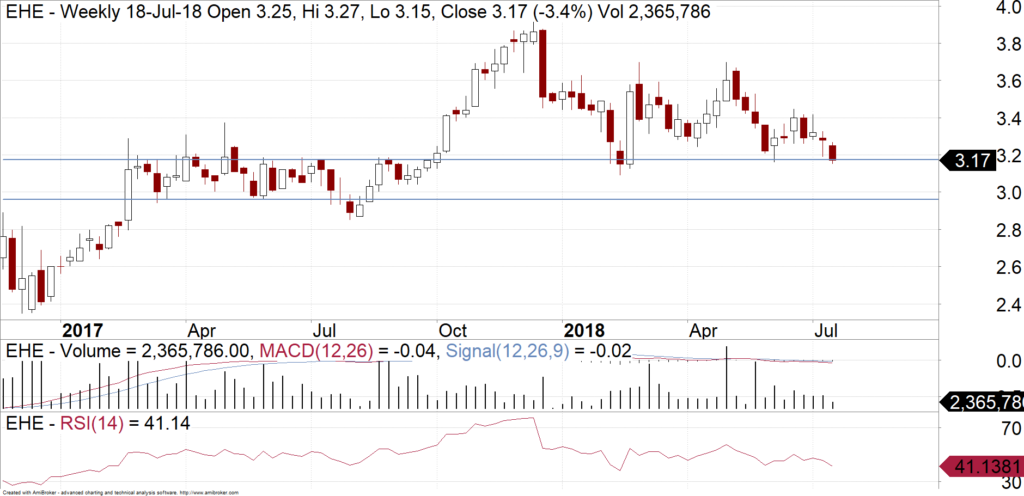The share price of Estia Health (ASX:EHE) has fallen significantly since the Federal Budget in May. We determine whether it now looks like a low risk buy from current levels. We also analyse the chart to determine whether we can see any share price support.
Overview of Estia Health
Estia Health is one of the largest private providers of residential aged care services in Australia. The Company has 68 homes in four Australian states. There are a further two homes to open in FY18 and a total of 6,023 operational beds. The business model is characterised by strong ongoing demand for residential aged care services that are underpinned by an ageing population.
Occupancy Rates Likely to Strengthen
Following a change of management and strategic review in the second half of calendar year 2016, there has been a steady improvement in occupancy since the end of November 2016.This was when occupancy declined to 92.8%. Occupancy in existing homes has been maintained at 94%, with the Company is targeting a 95% occupancy rate. This target appears achievable, as EHE has implemented a number of initiatives to, firstly, maintain occupancy rates and then achieve an incremental increase. In particular, the Company has:
i) Established a specialised occupancy team,
ii) Established a formal sales and client relations structure and
iii) Made high-performing facility directors responsible for making the necessary improvements to boost occupancy at underperforming sites.
Significant Bed Refurbishments
An increase in the portfolio of EHE’s bed portfolio receiving refurbishments is a key factor in increasing both the revenue and earnings generated per operating bed. To this end, EHE have outlined ~$250m in capital commitments into portfolio expansion and refurbishment. The majority of this is being directed to investment in new homes. The balance is on refurbishment programs, and investment into maintenance, sustainability and technology.
The improvement in occupancy towards the 95% target level and the revenue generated from additional services and significant bed refurbishments provide an opportunity to offset cost inflation and expand underlying EBITDA margin. Although, the expansion in underlying EBITDA margin is likely to be incremental. It is also expected to become evident from FY19. Underlying EBITDA margin for FY18 is expected to be flat in comparison to 1H18 (i.e. <17% in FY18 and slightly above 17% in FY19).
In context, the underlying EBITDA margin has declined from 20% in 2H16 and we contend that it is unlikely that the underlying EBITDA margin will recover to this level. There has been a step-up in the operating cost base since that time. This is a result of an increase in the staff, occupancy and resident expense lines.
Factors Impacting Sentiment on Estia Health
- The Company has outlined five projects that are either under development or in advanced planning. This will see the delivery of 345 beds in late FY19 and 240 beds in FY20. The earnings contributions from the development of these aged care facilities are unlikely to be material until FY20. This is because costs and depreciation increases ahead of the facilities maturing.
- The level of gearing (on a net debt to EBITDA basis) of 0.5x remains well below EHE’s optimal maximum leverage position of 1.5x – 1.8x EBITDA. While this provides the Company with significant balance sheet capacity to fund its development pipeline, the prospect for acquisitions in the short-term are limited given that sector multiples remain inflated.
- The market had been expecting some favourable measures in the last Federal Budget, which did not come to fruition. These included, firstly, any measures to reduce the impact from the recent Aged Care Funding Instrument (ACFI) on earnings growth for existing facilities. Secondly, measures to increase flexibility in pricing, in particular changes to the basic daily fee in residential care, including a requirement for providers to charge a minimum fee while allowing them to charge a higher fee to non-low means residents). The increased flexibility in pricing is seen as a positive for EHE. It potentially uncaps the basic daily care fee, which is receiving strong industry support. It would be a significant boost to EHE’s earnings over the next 2-3 years.
Overall View
These factors have led to share price weakness since the release of the Federal Budget – so at current levels, is EHE attractive?
In the absence of any major positive reforms and regulatory changes, it is hard to view EHE as anything other than a yield play, with the shares now trading on a 1-year forward yield of 5.4% and the medium-term distribution profile underpinned by the capital deployment program. Further, the share price has typically been sensitive to regulatory reforms and reviews into the Aged Care Sector that have taken place in recent years (which remain ongoing).
Chart of Estia Health
Strong support for Estia Health exists at current levels. Price has recently been fairly weak though. This means that we need to see a strong bounce from this level to be confident that support is holding. If that were to occur, then that would represent a buying opportunity for those looking at getting some yield. A failure at current levels would imply that EHE could fall towards levels just under $3.

Current share prices available here.
You can learn more about technical analysis in this article.
Michael Gable is managing director of Fairmont Equities.
Sign up to our newsletter. It comes out every week and its free!
Disclaimer: The information in this article is general advice only. Read our full disclaimer HERE.
Like this article? Share it now on Facebook and Twitter!

